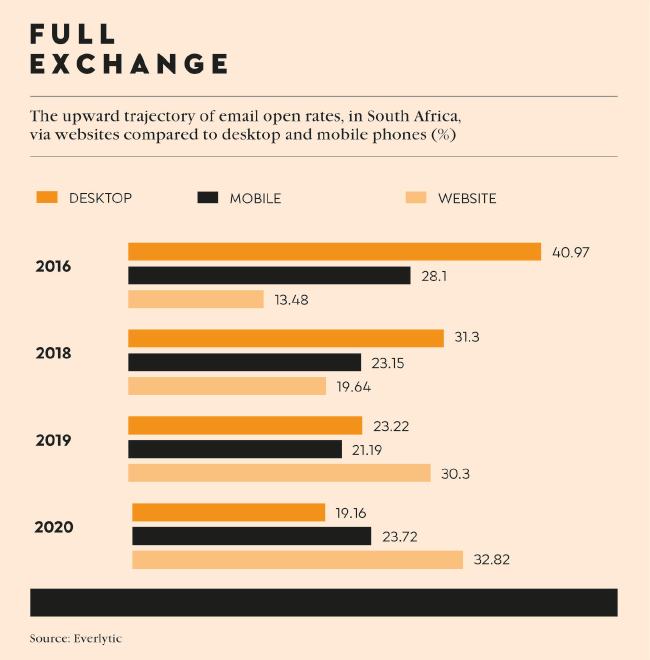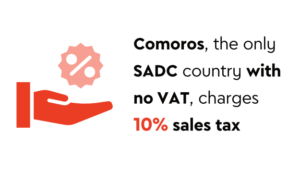At the turn of the millennium, a small side project developed by US internet entrepreneurs, featuring a mascot monkey named Frederick von Chimpenheimer IV, was created to help small-business owners who lacked high-end marketing tools and resources to grow their companies. Mailchimp, developed by Ben Chestnut and Dan Kurzius, launched in 2001 as an alternative to larger, more expensive communication products.
Nearly two decades later, in 2020, when the COVID-19 pandemic hit, the platform recorded a major spike in user engagement. In particular, small businesses – those with fewer than 2 000 contacts – using Mailchimp, recorded a 60% increase in use compared to March 2019’s pre-pandemic statistics. Mailchimp’s COVID-19 Email Marketing Trends report attributes this increase to the change in customer behaviour, noting that ‘as customer behaviours have shifted to accommodate “the new normal” in their work interactions and transactions, email has proven to be an effective tool for small businesses sending weekly updates to their subscribers’.
According Gilbert Kumpukwe, GM of Version Eight, a digital marketing agency based in Johannesburg, the onset of the COVID-19 pandemic made businesses, specially SMEs, realise just how cost-effective these simple platforms are – many of which, like Mailchimp, have been used in the marketplace for some time. ‘We believe small businesses will be able to reach much greater audiences, more targeted audiences, at a fraction of the cost [compared] to more traditional methods.’
One of the major benefits of e-marketing is that it doesn’t limit a company by physical manpower or time, says Kumpukwe. ‘There are only so many calls your sales rep can make in a normal working day, but there are hundreds of prospects you can reach in an hour via email prospecting. It costs a fraction to send out an email and reach 2 000 contacts [of what it would] to print out flyers and send them to 2 000 contacts, or to reach them by other means.’
David Dickens, CEO of the Direct Marketing Association of South Africa, agrees that the pandemic has definitely increased consumers’ use of technology, as 78% of internet users specifically searched products online prior to making the decision to purchase. The online customer journey, he says, must be kept in mind, and businesses need to have a presence across all digital channels.
According to SME South Africa, email marketing also allows businesses to connect with their customers and build credibility. ‘[It] combats some of the challenges that entrepreneurs face, including how to stand out as a business in a crowded marketplace, and how to engage with your current customers.’ Research by South African-based tech firm 2020 Everlytic – in which the recipient response to nearly 10 billion bulk emails, sent between January 2019 and December 2020, were analysed – supports Mailchimp’s findings… More South Africans interacted with email marketing during the pandemic than before. The average click-to-open rate in 2020 stood at 15.23%, compared to 11.81% the year before.
‘This is probably the sharpest year-on-year change we’ve ever seen to email marketing benchmark,’ the company states in a report. ‘Unsubscribes and complaints are also down across the board. This suggests that the contacts who have been opening emails during the pandemic have been engaged – as if 2020 unexpectedly showed all industries who their most engaged contacts were.’
Mailchimp currently has about 13 million users across the globe. Yet the platform is but one of the several methods of online brand communication seeing a pandemic-driven resurgence. ‘Search a product on Google and you’ll see Google ads; look at your Gmail inbox and you’ll see ads in a separate tab. Or visit social media and you’ll see ads from South African businesses,’ says Kumpukwe.

He adds that the shift to online marketing holds many advantages, including bigger profits for smaller businesses. ‘E-marketing has reduced their operational costs, which has further fuelled growth. And some have also replaced rental fees for the Zoom boardroom. What small businesses especially have had to do is look at other channels in order to continue generating business and awareness,’ he says. ‘COVID-19 has created a lot more interest in online because they see how effective it can be to drive traffic without having a store front or to give a presentation without ever physically meeting, or close a deal via a video conference. Online webinars have had a rediscovery because of their ability for businesses to reach people at a faster rate and far reaching than any other online. It has been much easier now with different platforms that provide hosting services that are easy and cost effective.’
The IMM Graduate School reiterates the benefits of e-marketing. ‘Digital marketing is profitable because it yields a high [return on investment], while simultaneously increasing scope and reach of the targeted audience,’ it states. This is a big plus for small and new businesses, as they are often operating with limited resources. Since campaigns are much more cost-effective to run digitally, this means a greater return on investment for businesses of any size.
E-marketing offers business owners the opportunity to keep up with their consumers’ changing needs, according to Dickens. ‘Your approach to traditional and digital marketing has to be fast-moving and agile. With many companies having to rapidly adopt technology during unprecedented times, consumers have also changed their buying behaviour. It’s more important than ever to keep your finger on the pulse of the latest digital trends and enhance your customers’ online experience.’
Kumpukwe adds that it’s also important to remember that each marketing platform operates differently. ‘For example, when marketing on social media, we must always remember that these platforms are “social first”, which means it’s less effective to simply copy and paste your advertising using traditional methods into an online poster. It’s important to understand how people use social media and any other online medium before looking at it as just another channel to sell your products or services on.’
SMS has also seen a recent increase in usage, which suits the steadily growing content-as-a-service (CaaS) market, says James Pearce, co-founder of SMSPortal. In an op-ed piece published in the Mail & Guardian, he notes that in 2020, 1.3 million businesses began using app-to-peer (A2P) messaging services. ‘This takes the total number of businesses using the channel globally to just under 8 million and represents an increase of 20% on the number using A2P SMS prior to the pandemic.’
Using SMS for marketing purposes remains effective, with UK-based SMS service provider Text Anywhere reporting a global 95% read rate. ‘We must remember that not everyone is as active online so SMS definitely has its place,’ says Kumpukwe. ‘The shift to online has actually left a gap in the market for SMS.’
Pearce adds that SMS marketing is about enabling consumers to act on the message in a quick and seamless manner. ‘An SMS will contain a shortened URL, so that consumers have access to a personalised branded web page, whenever they choose to access it,’ he says.
‘The art of CaaS is being where the market is and being able to engage with consumers in the manner that is best and most accessible for them.’
















